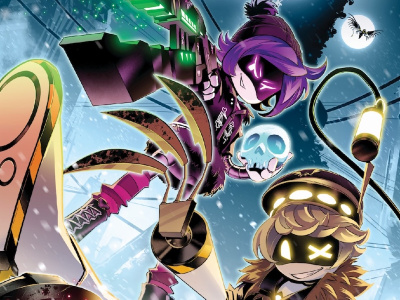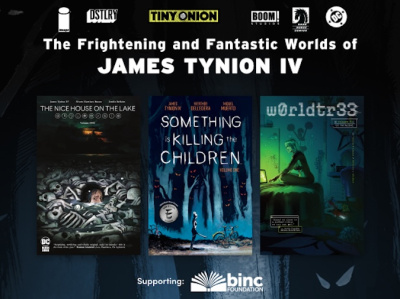
Recently ICv2 had a chance to sit down with Trevor Roth of Roddenberry Productions and Stephen Christy of Archaia and talk about their collaboration on the innovative science fiction mini-series Days Missing, which will debut with a full-size 99-cent first issue. In Part I of the interview they discuss the nature of the project and their unique approach in using multiple creative teams. In Part II they talk about marketing the Days Missing comics to Star Trek fans via the Web, at conventions and on iPhones.
The wary optimism of Star Trek and Roddenberry creations definitely appears to resonate with the zeitgeist of our era, judging from the success of the new movie, do you think you captured that in Days Missing?
Roth: I think that anybody who likes Star Trek whether it be the new movie or the old stuff, will definitely see that Roddenberry spirit, that Roddenberry philosophy embedded in Days Missing. When we first talked to Archaia about it and Stephen, who is not only very knowledgeable about Star Trek, but also very knowledgeable about comics, was able to hear this. We were literally able to look at each other and say, “This is Roddenberry,” to the point that when you pick up something of this nature, you will see such similarities in the creation and concept to Star Trek because we have been so true to the brand itself and the tradition, and yet we have evolved it into something brand new.
What is the schedule of Days Missing?
Christy: The first issue will go on sale at Comic-Con and will be distributed to stores in August. From then on it will be a monthly book, the second issue will be out in September, the third in October, the fourth in November, and the fifth in December with the trade collection due early in the spring of 2010. We are going to be doing a beautiful hardcover trade that will have some special features that weren’t in the original issues.
The trade collection should get wide distribution to libraries and bookstores, won’t it?
Christy: I am excited to see the final graphic novel, because the cool thing about this is it stays true to the spirit of Roddenberry in that it’s exciting, fun, and most importantly thought-provoking. It’s something with a spirit that is very similar to everything that Roddenberry has done before, and I think that being able to sit down with this in a really nice hardcover edition and being able to read through all the issues in one sitting, is going to be a lot of fun.
What is the plan for the creative teams, are you going to have a different team for each issue?
Roth: Yes, I think we have come up with something that works very, very well with our concept, by which we can really push the boundaries of comics and enhance this particular set of stories, and that entails having this first fantastic team of Phil Hester and Irving Frazier on issue #1, who will also bookend the project by doing issue #5 as well. Then for books 2, 3, and 4, there will be a different and very exciting, high-level team creative team doing each one of those issues, allowing us to really explore the creative possibilities of this book from a variety of different vantage points.
So you see an advantage to switching teams and getting a different “take” on the material before returning to the initial team?
Christy: One of the thing that we are trying to do with this project at Archaia is that we are very cognizant of how continuity heavy most monthly comics are, and the cool thing about Days Missing that we are trying to do is almost like going back to the original Star Trek series where every episode stands alone basically. You could just watch one episode and you would get a complete story. We are doing the same thing with this. Each issue of Days Missing is a stand-alone issue--that is something that Trevor and I, when we originally brainstorming the series, felt very strongly about. Once we arrived at the fact that each story would be a self-contained story, then we thought wouldn’t it be cool if we were just able to bring in more perspectives, more creative people into the process, and have a different creative team do every issue, really giving each book a unique feel.
Roth: We have spent a lot of time talking to each of the teams about a continuous arc that will umbrella the entire group of issues as well. When you look at our history, at everything that was created at Star Trek, we have tried to hit that mark again, really balancing something that is episodic and can stand alone, with the continuation of a story that can be compelling and emotionally intriguing.
How much can you tell us about that overarching story?
Roth: The general premise of the story that we have come up with really has to do with a being that we call “the Steward,” a being that has existed throughout the entirety of time. Through his interaction and interface with mankind he has helped shape our history, who we have been, who we are, and who we will be as a society and as human beings. And yet at the same time due to certain abilities he has--he has completely folded himself and time away so that until now, until the first issues of Days Missing come out, the history that he has been a part of is completely missing from our consciousness, from our textbooks, from our knowledge, and yet he has had an integral role in really guiding humanity since we evolved and perhaps until the end of time.
So the character of “the Steward” appears throughout the series?
Roth: Yes he’s our protagonist, he’s our hero, he’s our glue by which all of the days that we be exploring and seeing are put together.
But the comic books themselves all have self-contained storylines?
Christy: Every single issue is a new reader-friendly story, so a reader can pick up any issue and get a full 22-page, done-in-one-single issue story. For the fans who pick up all the books, they’re going to see a kind of richer tapestry and they’re going to get a sense of this overarching story that Hester and Irving are building. But every issue is entirely self-contained.
Roth: The idea was to create a collaborative balance between the overall concept that we had at the beginning, and then allowing each of creators, especially Hester and Irving to provide an encapsulated story either for the day or for the series that would really bring this concept to life.
Click here for Part II of the interview.







